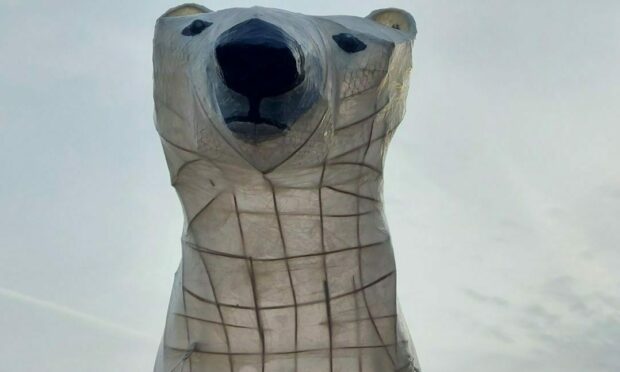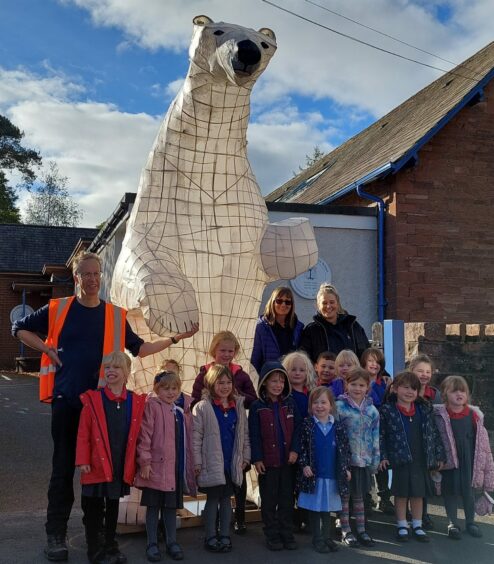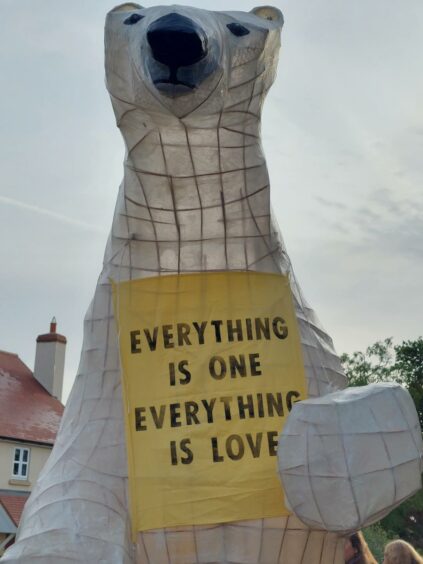An open-access online learning platform that offers school pupils across Scotland unique opportunities to undertake real-world challenges and skills-based courses founded on the UN Sustainable Development Goals, has been inspired by a ‘climate change bear’ during COP26.
The Futures Institute at Dollar Academy (FIDA), in Clackmannanshire, has adopted Clarion the Bear – a 10ft reinforced paper polar bear created by a Shropshire artist.
The school hosted a free two-day creative workshop for over 20 young people aged 14-18 from a number of Scottish schools to design and build Clarion an iceberg.
What is Clarion the Bear?
Clarion the Bear began his journey on October 10 in Shropshire, walking 306 miles over 23 days to COP26.
Created by artist Bamber Hawes, Clarion is made from thin bamboo poles, willow withies and many layers of heavy-duty tissue paper bonded together with waterproof PVA and carried on a palanquin.
Inspired by his epic journey, which saw its creator walk to COP26 in Glasgow, the FIDA team saw the possibility to place him at the heart of a design workshop for young people.
Across two days, students first explored how, down the ages, human societies have built monuments to reflect their values to future generations.
Then, working with professional architects, an artist, and a historian, they designed an iceberg for Clarion, forming a contemporary monument that captures a powerful message about climate change at the moment of COP26.
Challenging thinking
Dollar Academy rector Ian Munro said: “In this two-day event, students worked with practising architects, an artist and a historian to explore the many different meanings and forms which monuments can take, including innovative contemporary examples that challenge our thinking of what a monument can be.
“They discussed Clarion, and designed a new prototype home for him, as a wake-up call to the leaders assembled at COP26 and our whole generation.”
Artist Bamber Hawes said: “I do not think of him as a friendly cuddly bear, but as a bewildered, frightened beast that is angry about what humans have done to his world.”
Exploring how human societies throughout history and across cultures have created monuments, FIDA worked with artist Peter Nelson and two award-winning Scottish architects – Iain Shillady of Staran and John Brown of Page/Park.
The two day event enabled students to consider, challenge and create new design thinking centred around the UN Sustainable Development Goals, our planet and COP26.
Included within the two day course was a session on Henry Dundas, 1st Viscount Melville, and his monument, led by Michael Davies, founder of Parallel Histories – an organisation offering new ways to study conflicts and controversy through research and exploring historically conflicting perspectives.
Architectural design
Participants gained first-hand experience of the architectural design process from brainstorming to digital and physical modelling. They built a large-scale structure to provide Clarion with a new home.
The free of charge workshop hosted by Dollar was open to pupils from all schools.
Launched in May, FIDA was created at Dollar to address three fundamental challenges – sustainability, equitable access to education, and the need for curricular reform.
The platform enables young people to work with experts from industry and universities to better understand, and design solutions to, some of the most complex challenges faced, such as climate change, poverty and social injustice.
Built around a core offering of 17 Global Challenges – one for each of the UN SDGs – the project was built in partnership with industry and universities, including renowned textiles manufacturer Johnstons of Elgin, award-winning global architectural studio Grimshaw, and the Winton Centre for Risk and Evidence Communication, University of Cambridge.












